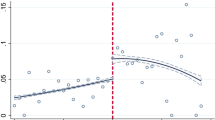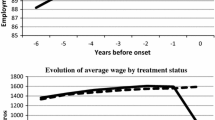Abstract
This paper studies the design of disability insurance scheme when agents differ in their privately known productivity. We extend the Diamond and Mirrlees (1978) two period model to allow for agents differing ex-ante in their productivity and characterize the optimal nonlinear tax transfer that maximizes a utilitarian welfare function when per-period earnings and age are observable while individuals’ productivity and health status are not observable. We show that the induced tax/benefit scheme should exhibit a marginal income tax that decreases with age for some agents. A marginal subsidy on the young high productive income may be desirable. While the disability scheme always involves the old low productive agents to be indifferent between working and claiming disability benefits, this result is not always true for the old high productive agents.
Similar content being viewed by others
References
Albanesi, S., & Sleet, C. (2005). Dynamic Optimal Taxation with Private Information. fothcoming in Review of Economic Studies.
Berlianty, M., & Ledyard, J. O. (2005). Optimal Dynamic Nonlinear Income Taxes with No Commitment. mimeo.
Blomqvist, A., & Horn, H. (1984). Public health insurance and optimal income taxation. Journal of Public Economics, 24, 352–371.
Boadway, R., Marceau, N., & Sato, M. (1999). Agency and the Design of Welfare Systems. Journal of Public Economics, 73, 1, 1–30.
Bound, John, & Richard V. B. (1999). Economic Analysis of Transfer Programs Targeted on People with Disabilities. In: O. Ashenfelter and D. Card (Eds.), Handbook of Labor Economics 3c (3417–3528).
Brito, Dagobert, L., Jonathan, H., Hamilton, Steven, M., Slutsky, & Joseph, E. S. (1991). Dynamic Optimal Income Taxation with Government Commitment. Journal of Public Economics, 44, 15–35.
Diamond, P., & Mirrlees, J. (1978). A Model of Social Insurance with Variable Retirement. Journal of Public Economics, 10, 295–336.
Diamond, P., & Mirrlees, J. (1986). Payroll Tax Financed Social Insurance with Variable Retirement. Scandinavian Journal of Economics, 88, 25–50.
Diamond, P., & Mirrlees, J. (1995). Social Insurance with Variable Retirement and Private Savings, unpublished.
Diamond, P., & Sheshinski, E. (1995). Economic Aspects of Optimal Disability Benefits. Journal of Public Economics, 57, 1–23.
Dillén, M., & Lundholm, M. (1996). Dynamic Income Taxation, Redistribution, and the Ratchet Effect. Journal of Public Economics, 59, 69–93.
Erosa, A., & Gervais, M. (2002). Optimal Taxation In Life Cycle Economies. Journal of Economic Theory, 105, 338–369.
Gaube, T. (2004). Optimum Taxation of each Years Income. mimeo.
Golosov, M., & Tsyvinski, A. (2003). Designing Optimal Disability Insurance. Federal Bank of Minneapolis Working Paper n 628.
Golosov, M., Kocherlakota, N., & Tsyvinski, A. (2003). Optimal indirect and Capital Taxation. The Review of Economic Studies, 70(3), 569–588.
Gruber, G., & Wise, D. (1999). Social Security and Retirement around the World. Chicago: The Chicago University Press.
Haveman R. H., & Wolfe, B.L. (2000). The Economics of Disability and Disability Policy. in A. J. Culyer and J. P. Newhouse (eds.) Handbook of Health Economics 1b (pp. 966–1051).
Kremer, M. (1997). Should Taxes Be Independent of Age? NBER Working Paper 6304.
Lozachmeur, J. M. (2005). Optimal Age Specific Income Taxation. forthcoming in Journal of Public Economic Theory.
Mirrlees, J. A. (1971). An Exploration in the Theory of Optimum Income Taxation. Review of Economic Studies, 38, 175–208.
Parsons, D.O. (1996). Imperfect ‘Tagging’ in Social Insurance Programs. Journal of Public Economics, 62, 183–207.
Whinston, M.D. (1983). Moral Hazard, Adverse Selection, and the Optimal Provision of Social Insurance. Journal of Public Economics, 22, 49–71.
Author information
Authors and Affiliations
Corresponding author
Additional information
JEL Classification H55 · H23 · E62
Rights and permissions
About this article
Cite this article
Lozachmeur, JM. Disability insurance and optimal income taxation. Int Tax Public Finan 13, 717–732 (2006). https://doi.org/10.1007/s10797-006-6692-1
Issue Date:
DOI: https://doi.org/10.1007/s10797-006-6692-1




